The Battle of the Nile
The Battle of the Nile was a significant naval victory for Great Britain over France in Egypt in August 1798. 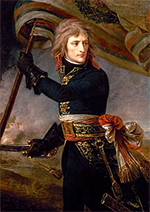
In early 1798, the French government had tasked Napoleon Bonaparte (left) with planning an invasion of Great Britain, with which France was still at war. Bonaparte concluded that the French navy didn't have the firepower to compete with the British Royal Navy and that it would better to invade Egypt and Syria, in an attempt to interfere with Britain's trade routes to India. This was more practical than it had been because Britain and Spain had gone to war in 1796 and the British naval force in the Mediterranean was little more than the outpost at Gibraltar. A French invasion of 35,000 soldiers on 200 ships sailed for Egypt in May 1798. French troops captured Malta and Alexandria and then, on July 21, defeated a combined force of Ottomans and the vaunted cavalry of the Mameluks at the Battle of the Pyramids. While the French ships were on their way to Malta, British ships sailed back into the Mediterranean for the first time in more than a year. The Royal Naval dispatched a squadron of six ships under the command of Rear-Admiral Sir Horatio Nelson to investigate. The British ships had to shelter near Corsica in order to wait out a fierce storm. That wait was sufficient for another 11 ships to join Nelson's The larger British contingent of ships, after Nelson (right) heard of French ship movements from other sailors, headed for Alexandria. Nelson had become convinced that the French force must be heading for Egypt. The British ships arrived in Alexandria on June 28 and found that no French force had arrived there. Nelson ordered his squadron northward, and the ships reached Anatolia on July 4. They they turned west, in order to sail back to Sicily. The French fleet, meanwhile, had arrived in Alexandria on June 29, just one day after the British fleet had arrived, and then seized control of the city two days later. They marched on toward Cairo, encountering and defeating the Mameluks and Ottomans on July 21. By the end of that month, the French army and fleet were back in Alexandria. Nelson's squadron, meanwhile, had resupplied at Sicily and had sailed back south. They arrived on August 1. 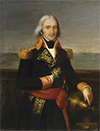
The French ships, under the command of Vice-Admiral François-Paul Brueys (left), had deployed across Aboukir Bay, not far from Alexandria. Once they knew that a battle with Britain was imminent, they went into defense mode, forming a battle line that sought to use the shoals to the French left as a natural defensive barrier. The ship commanders chose to focus their efforts on the starboard side of their ships, since they were counting on the shoals to prevent any attacks from the port side. As well, the soldiers had endured several weeks of hard fighting and were now stuck aboard ship with dwindling supplies of food and water; such a large force required large amounts of both, and so commanders deployed a number of foraging patrols to shoreline civilization. Not all of the foraging patrols were back aboard ship when the British ships arrived in Aboukir Bay. Brueys at first ordered his ships to set sail, then rescinded that order. He then saw the British ships slow and regain formation. 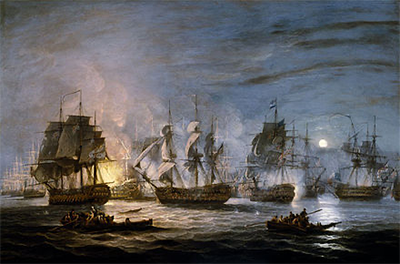
Nelson had given the order not to weigh anchor for the night but to attach the bow anchor, which would give the ships more of an ability to fire on the enemy without having to move very much. Then, they set sail again. It was after 6 p.m. when the first shots were fired. The two navies traded fire as the British ships closed in. One British ship, Captain Thomas Foley's Goliath, squeezed in the gap between the French ship Guerrier and the shoals. As the British ship sailed past the French ship on its port side, the defenders were unable to return fire with any kind of efficiency. A second British ship appeared next to the first, and the withering fire on the French ship intensified. Another British ship appeared to the starboard of Guerrier, and the French ship took a royal pounding. It surrendered not long afterward. 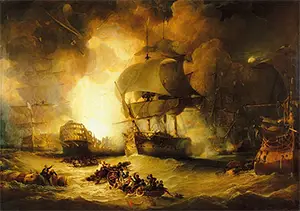
French ships did have some success. The mighty flagship L'Orient, firing more than 100 guns, crippled the British ship Bellerophon. But withering fire from British ships created a fire aboard L'Orient, and the flagship blew up just after 10 p.m. By that time, six other French ships had surrendered. Sporadic fighting continued through the night, ramping up again with the sunrise. The rear line of the French contingent attempted a breakout and had limited success. Of the 17 ships that took part in the Battle of the Nile, only four escaped. The British didn't have it all their way. The Culloden ran aground in the early stages of the battle. Nelson himself, already missing an eye and an arm, suffered severe physical distress. A bit of shrapnel hit him in the forehead, dislodging a flap of skin over the eye out of which he could see; he was out of action for only a few minutes, thanks to the quick actions of the ship's surgeon. Estimates of casualties vary by source. British killed and wounded did not exceed 1,000, whereas French losses are thought to have been at least twice and perhaps three or four times as large. French dead included Bueys. The victory emboldened other European powers, and it wasn't long until France was fighting another alliance, in the War of the Second Coalition.
|
|
Social Studies for Kids
copyright 2002–2025
David White



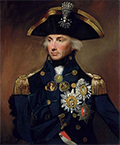 squadron.
squadron.
